Contemporary Issue: Diabetes Mellitus Analysis in the United Kingdom
VerifiedAdded on 2020/07/22
|13
|4184
|127
Report
AI Summary
This report provides a comprehensive overview of diabetes as a contemporary issue in the United Kingdom. It begins with an executive summary highlighting the metabolic disorder's nature and acute complications. The report then delves into the background, analyzing the reasons why diabetes is a pressing issue in the UK, including its non-curable nature and increasing prevalence due to lifestyle changes. Key issues related to diabetes, such as its impact on various body systems (kidneys, eyes, nerves, etc.) and associated health problems like cardiovascular disease and neuropathy, are discussed. Statistical data, including the estimated prevalence of diabetes worldwide and in the UK, obesity rates, and the financial burden on the NHS, are presented. The report also explores the chronological and geographical implications of diabetes, comparing treatment advancements and highlighting the global prevalence of the disease. Government legislations and the application of relevant theories to analyze diabetes are also included, concluding with recommendations to address the growing health crisis. The report emphasizes the need for lifestyle modifications, early detection, and effective management strategies to mitigate the impact of diabetes.

Contemporary issue-
Diabetes
Diabetes
Paraphrase This Document
Need a fresh take? Get an instant paraphrase of this document with our AI Paraphraser

Executive Summary
Diabetes Mellitus, which is generally referred to as diabetes, is a group of metabolic
disorders. In this state, blood sugar levels tend to rise over a prolonged period. Common acute
complications that are related to it include hyperglycaemic state, diabetic ketoacidosis or death as
well. People with high blood sugar level can have poor flow of blood in the endings of the nerve
of the body. It leads to slow healing of sores and one can experience severe and unbearable pain
as well. There are around 175 million people who are left undiagnosed and have higher chances
that they are suffering from type 2 diabetes. Standard one of NHS states regarding developing,
implementing ang monitoring strategies that can help in reducing the overall risk of development
of type 2 diabetes as a whole. The recommendation related to it is Medical institution must take
high initiatives for promoting the usage of assessments by medical staff and improving the
treatment decisions.
Diabetes Mellitus, which is generally referred to as diabetes, is a group of metabolic
disorders. In this state, blood sugar levels tend to rise over a prolonged period. Common acute
complications that are related to it include hyperglycaemic state, diabetic ketoacidosis or death as
well. People with high blood sugar level can have poor flow of blood in the endings of the nerve
of the body. It leads to slow healing of sores and one can experience severe and unbearable pain
as well. There are around 175 million people who are left undiagnosed and have higher chances
that they are suffering from type 2 diabetes. Standard one of NHS states regarding developing,
implementing ang monitoring strategies that can help in reducing the overall risk of development
of type 2 diabetes as a whole. The recommendation related to it is Medical institution must take
high initiatives for promoting the usage of assessments by medical staff and improving the
treatment decisions.
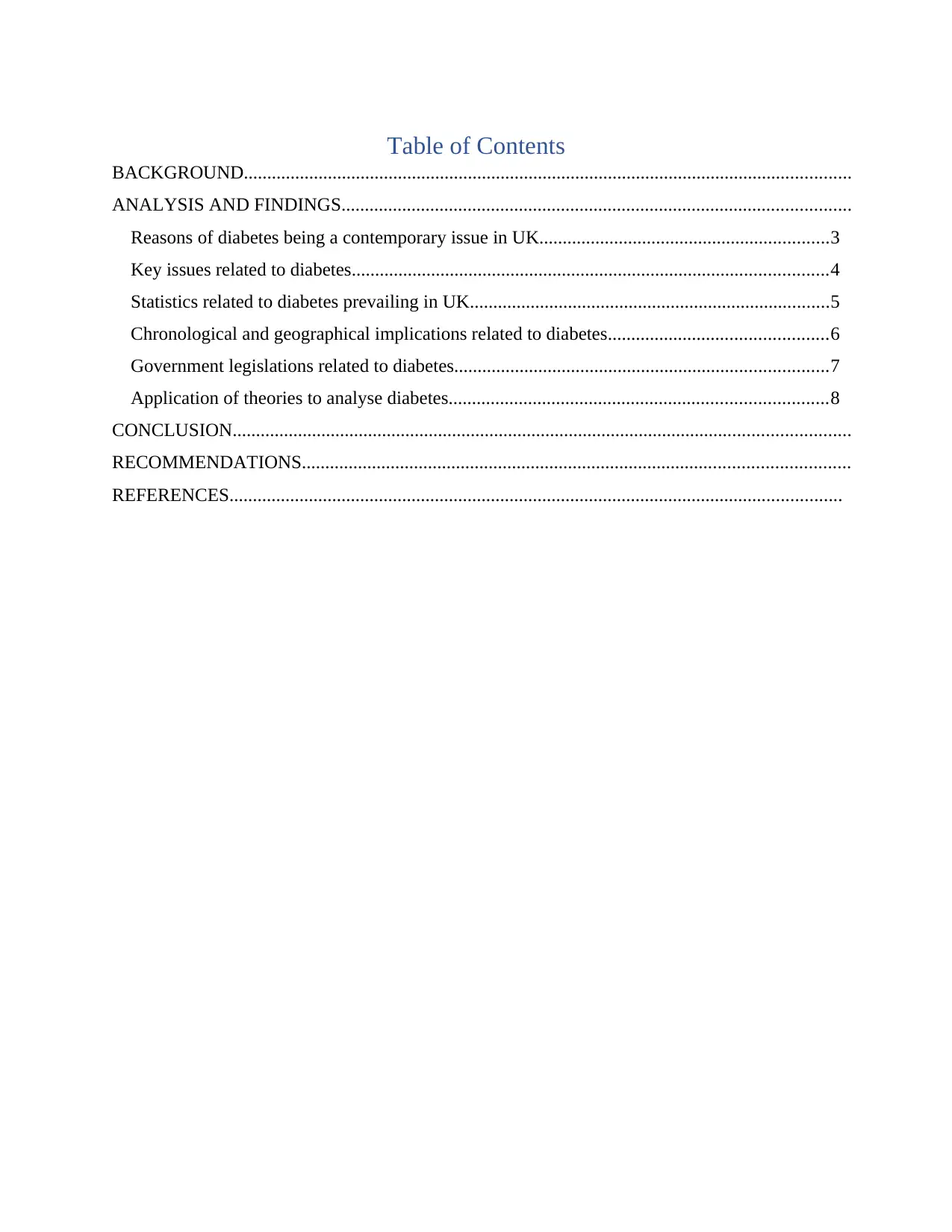
Table of Contents
BACKGROUND..................................................................................................................................
ANALYSIS AND FINDINGS.............................................................................................................
Reasons of diabetes being a contemporary issue in UK..............................................................3
Key issues related to diabetes......................................................................................................4
Statistics related to diabetes prevailing in UK.............................................................................5
Chronological and geographical implications related to diabetes...............................................6
Government legislations related to diabetes................................................................................7
Application of theories to analyse diabetes.................................................................................8
CONCLUSION....................................................................................................................................
RECOMMENDATIONS.....................................................................................................................
REFERENCES...................................................................................................................................
BACKGROUND..................................................................................................................................
ANALYSIS AND FINDINGS.............................................................................................................
Reasons of diabetes being a contemporary issue in UK..............................................................3
Key issues related to diabetes......................................................................................................4
Statistics related to diabetes prevailing in UK.............................................................................5
Chronological and geographical implications related to diabetes...............................................6
Government legislations related to diabetes................................................................................7
Application of theories to analyse diabetes.................................................................................8
CONCLUSION....................................................................................................................................
RECOMMENDATIONS.....................................................................................................................
REFERENCES...................................................................................................................................
⊘ This is a preview!⊘
Do you want full access?
Subscribe today to unlock all pages.

Trusted by 1+ million students worldwide
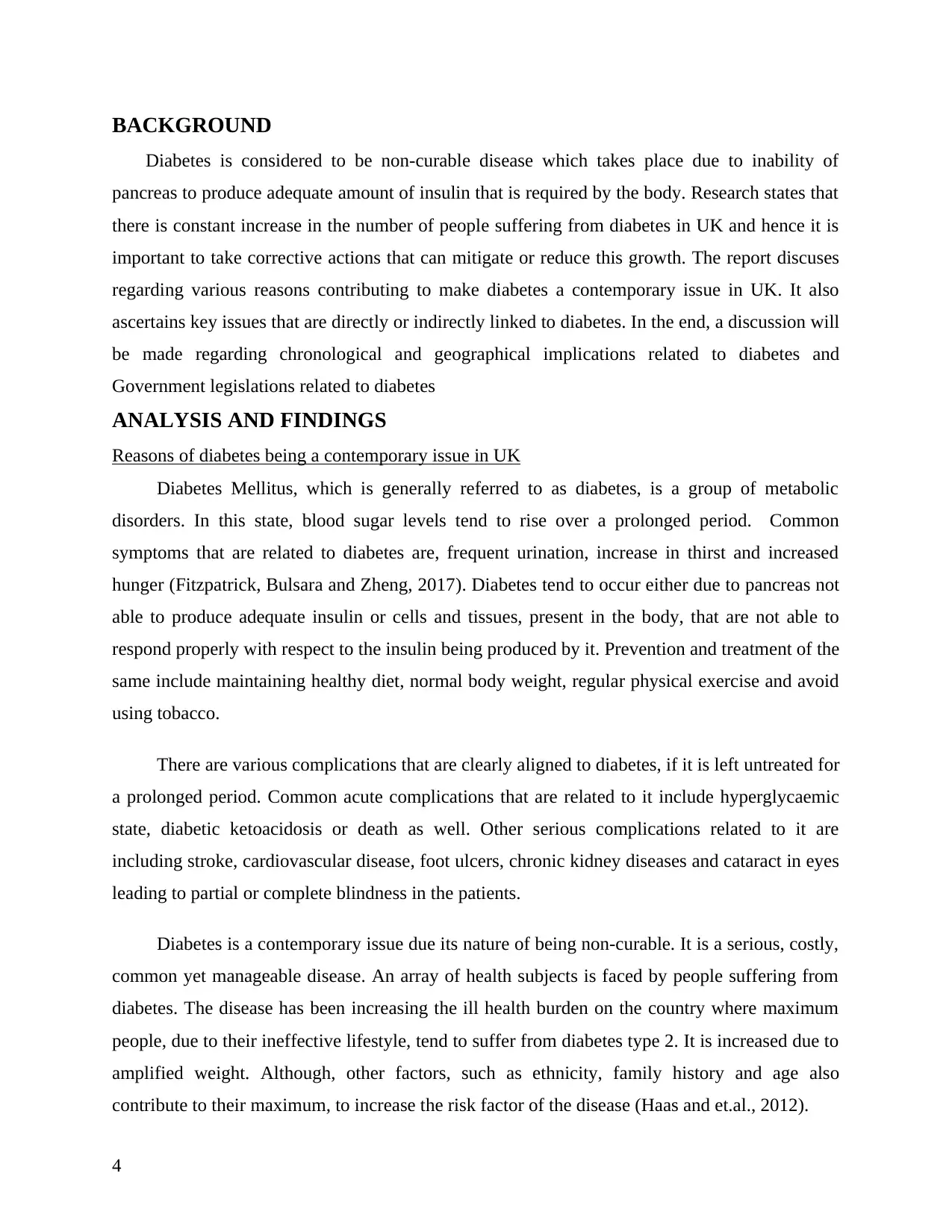
BACKGROUND
Diabetes is considered to be non-curable disease which takes place due to inability of
pancreas to produce adequate amount of insulin that is required by the body. Research states that
there is constant increase in the number of people suffering from diabetes in UK and hence it is
important to take corrective actions that can mitigate or reduce this growth. The report discuses
regarding various reasons contributing to make diabetes a contemporary issue in UK. It also
ascertains key issues that are directly or indirectly linked to diabetes. In the end, a discussion will
be made regarding chronological and geographical implications related to diabetes and
Government legislations related to diabetes
ANALYSIS AND FINDINGS
Reasons of diabetes being a contemporary issue in UK
Diabetes Mellitus, which is generally referred to as diabetes, is a group of metabolic
disorders. In this state, blood sugar levels tend to rise over a prolonged period. Common
symptoms that are related to diabetes are, frequent urination, increase in thirst and increased
hunger (Fitzpatrick, Bulsara and Zheng, 2017). Diabetes tend to occur either due to pancreas not
able to produce adequate insulin or cells and tissues, present in the body, that are not able to
respond properly with respect to the insulin being produced by it. Prevention and treatment of the
same include maintaining healthy diet, normal body weight, regular physical exercise and avoid
using tobacco.
There are various complications that are clearly aligned to diabetes, if it is left untreated for
a prolonged period. Common acute complications that are related to it include hyperglycaemic
state, diabetic ketoacidosis or death as well. Other serious complications related to it are
including stroke, cardiovascular disease, foot ulcers, chronic kidney diseases and cataract in eyes
leading to partial or complete blindness in the patients.
Diabetes is a contemporary issue due its nature of being non-curable. It is a serious, costly,
common yet manageable disease. An array of health subjects is faced by people suffering from
diabetes. The disease has been increasing the ill health burden on the country where maximum
people, due to their ineffective lifestyle, tend to suffer from diabetes type 2. It is increased due to
amplified weight. Although, other factors, such as ethnicity, family history and age also
contribute to their maximum, to increase the risk factor of the disease (Haas and et.al., 2012).
4
Diabetes is considered to be non-curable disease which takes place due to inability of
pancreas to produce adequate amount of insulin that is required by the body. Research states that
there is constant increase in the number of people suffering from diabetes in UK and hence it is
important to take corrective actions that can mitigate or reduce this growth. The report discuses
regarding various reasons contributing to make diabetes a contemporary issue in UK. It also
ascertains key issues that are directly or indirectly linked to diabetes. In the end, a discussion will
be made regarding chronological and geographical implications related to diabetes and
Government legislations related to diabetes
ANALYSIS AND FINDINGS
Reasons of diabetes being a contemporary issue in UK
Diabetes Mellitus, which is generally referred to as diabetes, is a group of metabolic
disorders. In this state, blood sugar levels tend to rise over a prolonged period. Common
symptoms that are related to diabetes are, frequent urination, increase in thirst and increased
hunger (Fitzpatrick, Bulsara and Zheng, 2017). Diabetes tend to occur either due to pancreas not
able to produce adequate insulin or cells and tissues, present in the body, that are not able to
respond properly with respect to the insulin being produced by it. Prevention and treatment of the
same include maintaining healthy diet, normal body weight, regular physical exercise and avoid
using tobacco.
There are various complications that are clearly aligned to diabetes, if it is left untreated for
a prolonged period. Common acute complications that are related to it include hyperglycaemic
state, diabetic ketoacidosis or death as well. Other serious complications related to it are
including stroke, cardiovascular disease, foot ulcers, chronic kidney diseases and cataract in eyes
leading to partial or complete blindness in the patients.
Diabetes is a contemporary issue due its nature of being non-curable. It is a serious, costly,
common yet manageable disease. An array of health subjects is faced by people suffering from
diabetes. The disease has been increasing the ill health burden on the country where maximum
people, due to their ineffective lifestyle, tend to suffer from diabetes type 2. It is increased due to
amplified weight. Although, other factors, such as ethnicity, family history and age also
contribute to their maximum, to increase the risk factor of the disease (Haas and et.al., 2012).
4
Paraphrase This Document
Need a fresh take? Get an instant paraphrase of this document with our AI Paraphraser

Changing lifestyle of people in UK have improved the prevalence of the disease. It has
increased the concern of authorities and has generated the requirements of taking appropriate
steps that can help in controlling its prevalence to the minimum. Hence, it can be stated that
diabetes has become a contemporary issue prevailing in UK.
Key issues related to diabetes
People who suffer from diabetes can face various long and short-term health issues. It has
an adequate impact on individual's kidneys, eyes, brain, feet and nerves. The only method to
control these issues from prevailing in the body is by controlling blood sugar level. It is
important for the patient to get into regular eye check-up. A person with diabetes can commonly
suffer from cataract, glaucoma and retinopathy. There can be increased chances of
cardiovascular and stroke. Since, obesity is a common symptom with leads to increased blood
pressure. It can have negative effect on heart and brain of the individuals as well (Haas and et.al.,
2012).
People with high blood sugar level can have poor flow of blood in the endings of the
nerve of the body. It leads to slow healing of sores and one can experience severe and unbearable
pain as well. In serious cases, amputation technique is generally preferred by the doctor due to
presence of chronic sores. Neuropathy can also appear in the patients with diabetes. The damage
can occur in peripheral nervous system and in the nerves of internal organs. Individuals also
suffer from postural hypotension, gastroparesis and uncontrolled diarrhoea as well.
Blood sugar is often the most underestimated content present in the body. Since, it affects
the body's condition of preparing insulin in the body. It has a high amount of impact on the body.
It can be in the form of sweet smelling breath, risk infections, pancreas malfunctioning, high
blood pressure, fatigue and lack of energy, protein in urine, keto acidosis, damage in the blood
cells and foot issues. It increases the risk of cardiovascular disease, coronary heart disease heart
attack, stroke, narrowing down of arteries (Healy and et.al., 2013).
The number of people with diabetes are steadily increasing. Authorities have been
working on it so that they can bring down the number of diabetic people in the country. Its
complications have been costing almost £10 billion a year to NHS. Appropriate steps taken by
the team, through life style modifications and reverse the changing trends of health can help in
safeguarding the future of people from occurrence of this disease.
5
increased the concern of authorities and has generated the requirements of taking appropriate
steps that can help in controlling its prevalence to the minimum. Hence, it can be stated that
diabetes has become a contemporary issue prevailing in UK.
Key issues related to diabetes
People who suffer from diabetes can face various long and short-term health issues. It has
an adequate impact on individual's kidneys, eyes, brain, feet and nerves. The only method to
control these issues from prevailing in the body is by controlling blood sugar level. It is
important for the patient to get into regular eye check-up. A person with diabetes can commonly
suffer from cataract, glaucoma and retinopathy. There can be increased chances of
cardiovascular and stroke. Since, obesity is a common symptom with leads to increased blood
pressure. It can have negative effect on heart and brain of the individuals as well (Haas and et.al.,
2012).
People with high blood sugar level can have poor flow of blood in the endings of the
nerve of the body. It leads to slow healing of sores and one can experience severe and unbearable
pain as well. In serious cases, amputation technique is generally preferred by the doctor due to
presence of chronic sores. Neuropathy can also appear in the patients with diabetes. The damage
can occur in peripheral nervous system and in the nerves of internal organs. Individuals also
suffer from postural hypotension, gastroparesis and uncontrolled diarrhoea as well.
Blood sugar is often the most underestimated content present in the body. Since, it affects
the body's condition of preparing insulin in the body. It has a high amount of impact on the body.
It can be in the form of sweet smelling breath, risk infections, pancreas malfunctioning, high
blood pressure, fatigue and lack of energy, protein in urine, keto acidosis, damage in the blood
cells and foot issues. It increases the risk of cardiovascular disease, coronary heart disease heart
attack, stroke, narrowing down of arteries (Healy and et.al., 2013).
The number of people with diabetes are steadily increasing. Authorities have been
working on it so that they can bring down the number of diabetic people in the country. Its
complications have been costing almost £10 billion a year to NHS. Appropriate steps taken by
the team, through life style modifications and reverse the changing trends of health can help in
safeguarding the future of people from occurrence of this disease.
5
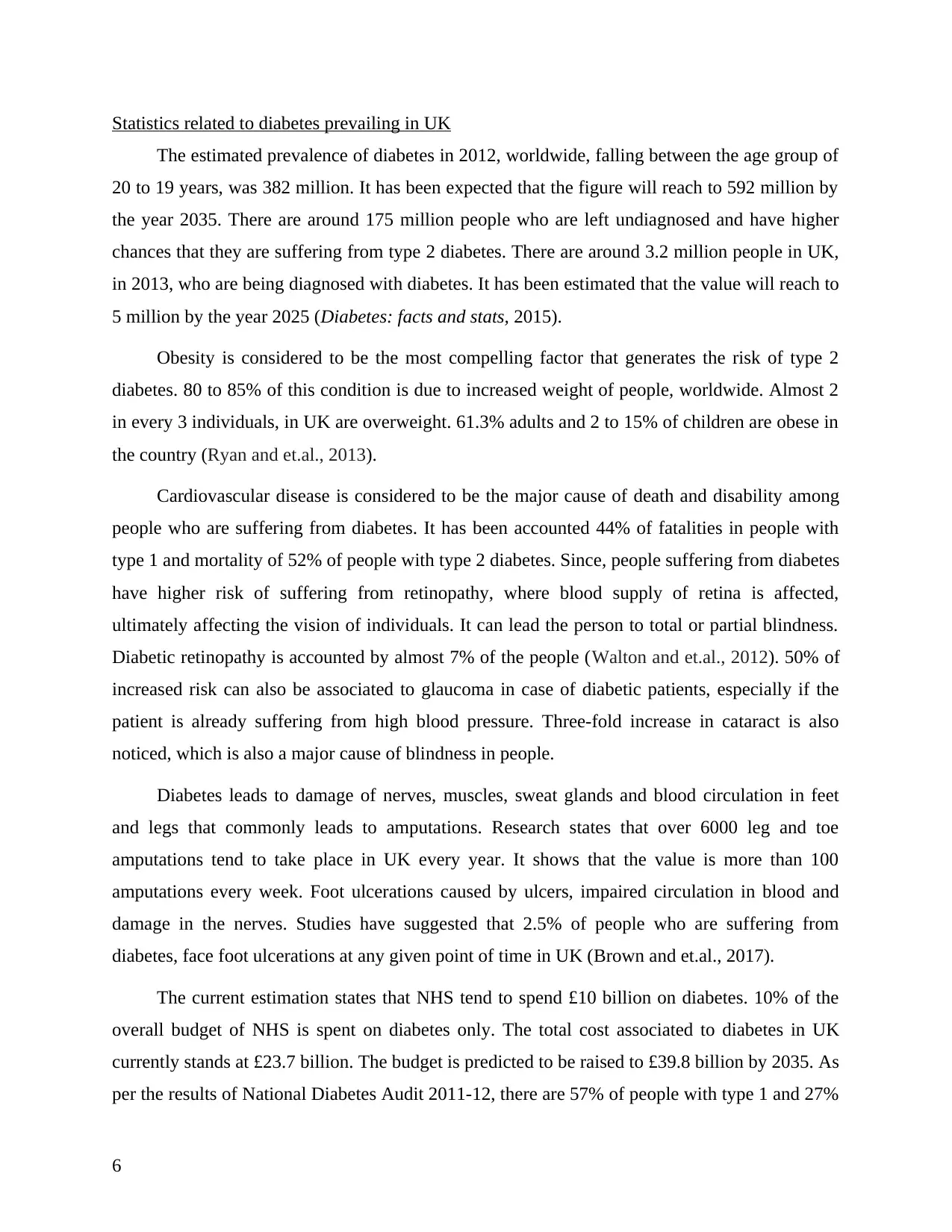
Statistics related to diabetes prevailing in UK
The estimated prevalence of diabetes in 2012, worldwide, falling between the age group of
20 to 19 years, was 382 million. It has been expected that the figure will reach to 592 million by
the year 2035. There are around 175 million people who are left undiagnosed and have higher
chances that they are suffering from type 2 diabetes. There are around 3.2 million people in UK,
in 2013, who are being diagnosed with diabetes. It has been estimated that the value will reach to
5 million by the year 2025 (Diabetes: facts and stats, 2015).
Obesity is considered to be the most compelling factor that generates the risk of type 2
diabetes. 80 to 85% of this condition is due to increased weight of people, worldwide. Almost 2
in every 3 individuals, in UK are overweight. 61.3% adults and 2 to 15% of children are obese in
the country (Ryan and et.al., 2013).
Cardiovascular disease is considered to be the major cause of death and disability among
people who are suffering from diabetes. It has been accounted 44% of fatalities in people with
type 1 and mortality of 52% of people with type 2 diabetes. Since, people suffering from diabetes
have higher risk of suffering from retinopathy, where blood supply of retina is affected,
ultimately affecting the vision of individuals. It can lead the person to total or partial blindness.
Diabetic retinopathy is accounted by almost 7% of the people (Walton and et.al., 2012). 50% of
increased risk can also be associated to glaucoma in case of diabetic patients, especially if the
patient is already suffering from high blood pressure. Three-fold increase in cataract is also
noticed, which is also a major cause of blindness in people.
Diabetes leads to damage of nerves, muscles, sweat glands and blood circulation in feet
and legs that commonly leads to amputations. Research states that over 6000 leg and toe
amputations tend to take place in UK every year. It shows that the value is more than 100
amputations every week. Foot ulcerations caused by ulcers, impaired circulation in blood and
damage in the nerves. Studies have suggested that 2.5% of people who are suffering from
diabetes, face foot ulcerations at any given point of time in UK (Brown and et.al., 2017).
The current estimation states that NHS tend to spend £10 billion on diabetes. 10% of the
overall budget of NHS is spent on diabetes only. The total cost associated to diabetes in UK
currently stands at £23.7 billion. The budget is predicted to be raised to £39.8 billion by 2035. As
per the results of National Diabetes Audit 2011-12, there are 57% of people with type 1 and 27%
6
The estimated prevalence of diabetes in 2012, worldwide, falling between the age group of
20 to 19 years, was 382 million. It has been expected that the figure will reach to 592 million by
the year 2035. There are around 175 million people who are left undiagnosed and have higher
chances that they are suffering from type 2 diabetes. There are around 3.2 million people in UK,
in 2013, who are being diagnosed with diabetes. It has been estimated that the value will reach to
5 million by the year 2025 (Diabetes: facts and stats, 2015).
Obesity is considered to be the most compelling factor that generates the risk of type 2
diabetes. 80 to 85% of this condition is due to increased weight of people, worldwide. Almost 2
in every 3 individuals, in UK are overweight. 61.3% adults and 2 to 15% of children are obese in
the country (Ryan and et.al., 2013).
Cardiovascular disease is considered to be the major cause of death and disability among
people who are suffering from diabetes. It has been accounted 44% of fatalities in people with
type 1 and mortality of 52% of people with type 2 diabetes. Since, people suffering from diabetes
have higher risk of suffering from retinopathy, where blood supply of retina is affected,
ultimately affecting the vision of individuals. It can lead the person to total or partial blindness.
Diabetic retinopathy is accounted by almost 7% of the people (Walton and et.al., 2012). 50% of
increased risk can also be associated to glaucoma in case of diabetic patients, especially if the
patient is already suffering from high blood pressure. Three-fold increase in cataract is also
noticed, which is also a major cause of blindness in people.
Diabetes leads to damage of nerves, muscles, sweat glands and blood circulation in feet
and legs that commonly leads to amputations. Research states that over 6000 leg and toe
amputations tend to take place in UK every year. It shows that the value is more than 100
amputations every week. Foot ulcerations caused by ulcers, impaired circulation in blood and
damage in the nerves. Studies have suggested that 2.5% of people who are suffering from
diabetes, face foot ulcerations at any given point of time in UK (Brown and et.al., 2017).
The current estimation states that NHS tend to spend £10 billion on diabetes. 10% of the
overall budget of NHS is spent on diabetes only. The total cost associated to diabetes in UK
currently stands at £23.7 billion. The budget is predicted to be raised to £39.8 billion by 2035. As
per the results of National Diabetes Audit 2011-12, there are 57% of people with type 1 and 27%
6
⊘ This is a preview!⊘
Do you want full access?
Subscribe today to unlock all pages.

Trusted by 1+ million students worldwide
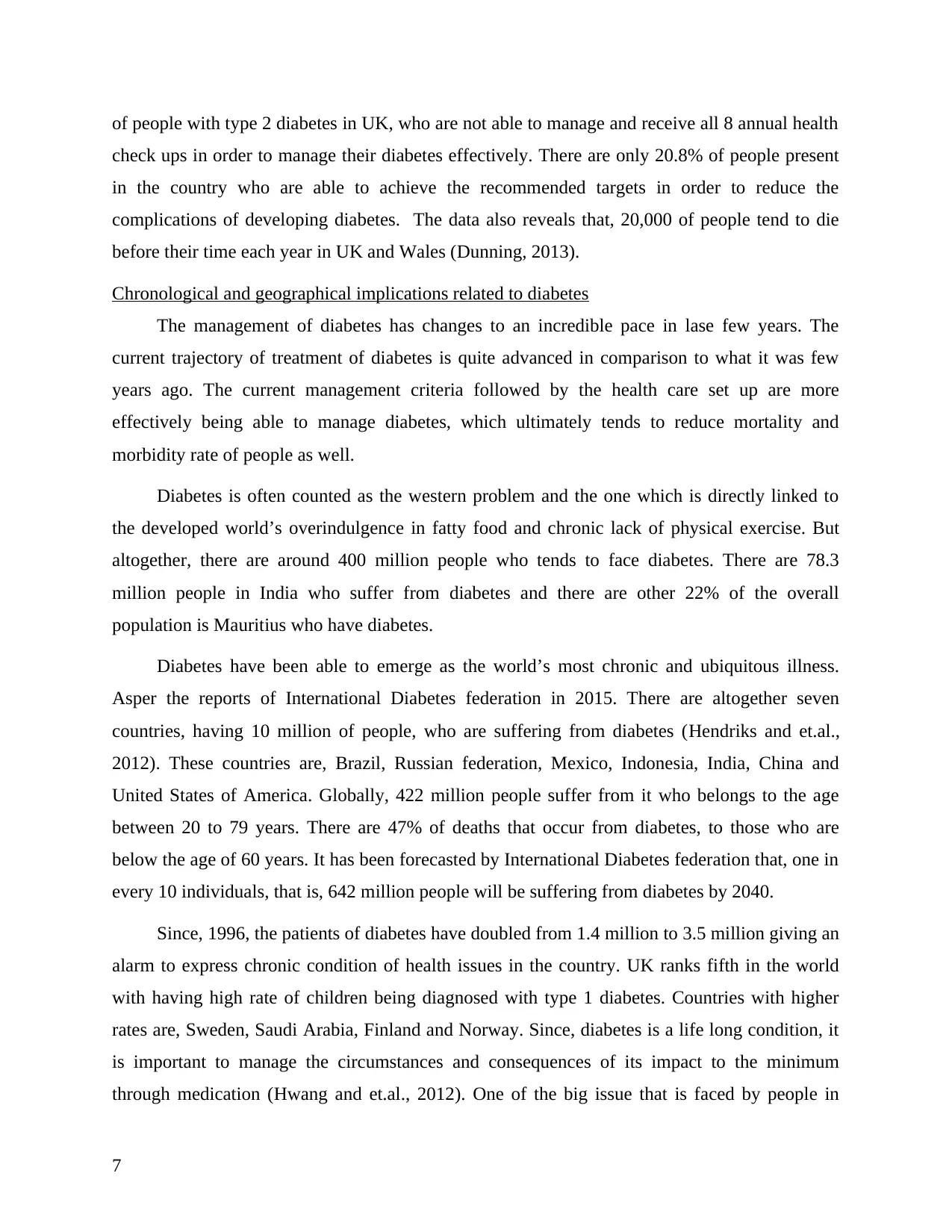
of people with type 2 diabetes in UK, who are not able to manage and receive all 8 annual health
check ups in order to manage their diabetes effectively. There are only 20.8% of people present
in the country who are able to achieve the recommended targets in order to reduce the
complications of developing diabetes. The data also reveals that, 20,000 of people tend to die
before their time each year in UK and Wales (Dunning, 2013).
Chronological and geographical implications related to diabetes
The management of diabetes has changes to an incredible pace in lase few years. The
current trajectory of treatment of diabetes is quite advanced in comparison to what it was few
years ago. The current management criteria followed by the health care set up are more
effectively being able to manage diabetes, which ultimately tends to reduce mortality and
morbidity rate of people as well.
Diabetes is often counted as the western problem and the one which is directly linked to
the developed world’s overindulgence in fatty food and chronic lack of physical exercise. But
altogether, there are around 400 million people who tends to face diabetes. There are 78.3
million people in India who suffer from diabetes and there are other 22% of the overall
population is Mauritius who have diabetes.
Diabetes have been able to emerge as the world’s most chronic and ubiquitous illness.
Asper the reports of International Diabetes federation in 2015. There are altogether seven
countries, having 10 million of people, who are suffering from diabetes (Hendriks and et.al.,
2012). These countries are, Brazil, Russian federation, Mexico, Indonesia, India, China and
United States of America. Globally, 422 million people suffer from it who belongs to the age
between 20 to 79 years. There are 47% of deaths that occur from diabetes, to those who are
below the age of 60 years. It has been forecasted by International Diabetes federation that, one in
every 10 individuals, that is, 642 million people will be suffering from diabetes by 2040.
Since, 1996, the patients of diabetes have doubled from 1.4 million to 3.5 million giving an
alarm to express chronic condition of health issues in the country. UK ranks fifth in the world
with having high rate of children being diagnosed with type 1 diabetes. Countries with higher
rates are, Sweden, Saudi Arabia, Finland and Norway. Since, diabetes is a life long condition, it
is important to manage the circumstances and consequences of its impact to the minimum
through medication (Hwang and et.al., 2012). One of the big issue that is faced by people in
7
check ups in order to manage their diabetes effectively. There are only 20.8% of people present
in the country who are able to achieve the recommended targets in order to reduce the
complications of developing diabetes. The data also reveals that, 20,000 of people tend to die
before their time each year in UK and Wales (Dunning, 2013).
Chronological and geographical implications related to diabetes
The management of diabetes has changes to an incredible pace in lase few years. The
current trajectory of treatment of diabetes is quite advanced in comparison to what it was few
years ago. The current management criteria followed by the health care set up are more
effectively being able to manage diabetes, which ultimately tends to reduce mortality and
morbidity rate of people as well.
Diabetes is often counted as the western problem and the one which is directly linked to
the developed world’s overindulgence in fatty food and chronic lack of physical exercise. But
altogether, there are around 400 million people who tends to face diabetes. There are 78.3
million people in India who suffer from diabetes and there are other 22% of the overall
population is Mauritius who have diabetes.
Diabetes have been able to emerge as the world’s most chronic and ubiquitous illness.
Asper the reports of International Diabetes federation in 2015. There are altogether seven
countries, having 10 million of people, who are suffering from diabetes (Hendriks and et.al.,
2012). These countries are, Brazil, Russian federation, Mexico, Indonesia, India, China and
United States of America. Globally, 422 million people suffer from it who belongs to the age
between 20 to 79 years. There are 47% of deaths that occur from diabetes, to those who are
below the age of 60 years. It has been forecasted by International Diabetes federation that, one in
every 10 individuals, that is, 642 million people will be suffering from diabetes by 2040.
Since, 1996, the patients of diabetes have doubled from 1.4 million to 3.5 million giving an
alarm to express chronic condition of health issues in the country. UK ranks fifth in the world
with having high rate of children being diagnosed with type 1 diabetes. Countries with higher
rates are, Sweden, Saudi Arabia, Finland and Norway. Since, diabetes is a life long condition, it
is important to manage the circumstances and consequences of its impact to the minimum
through medication (Hwang and et.al., 2012). One of the big issue that is faced by people in
7
Paraphrase This Document
Need a fresh take? Get an instant paraphrase of this document with our AI Paraphraser
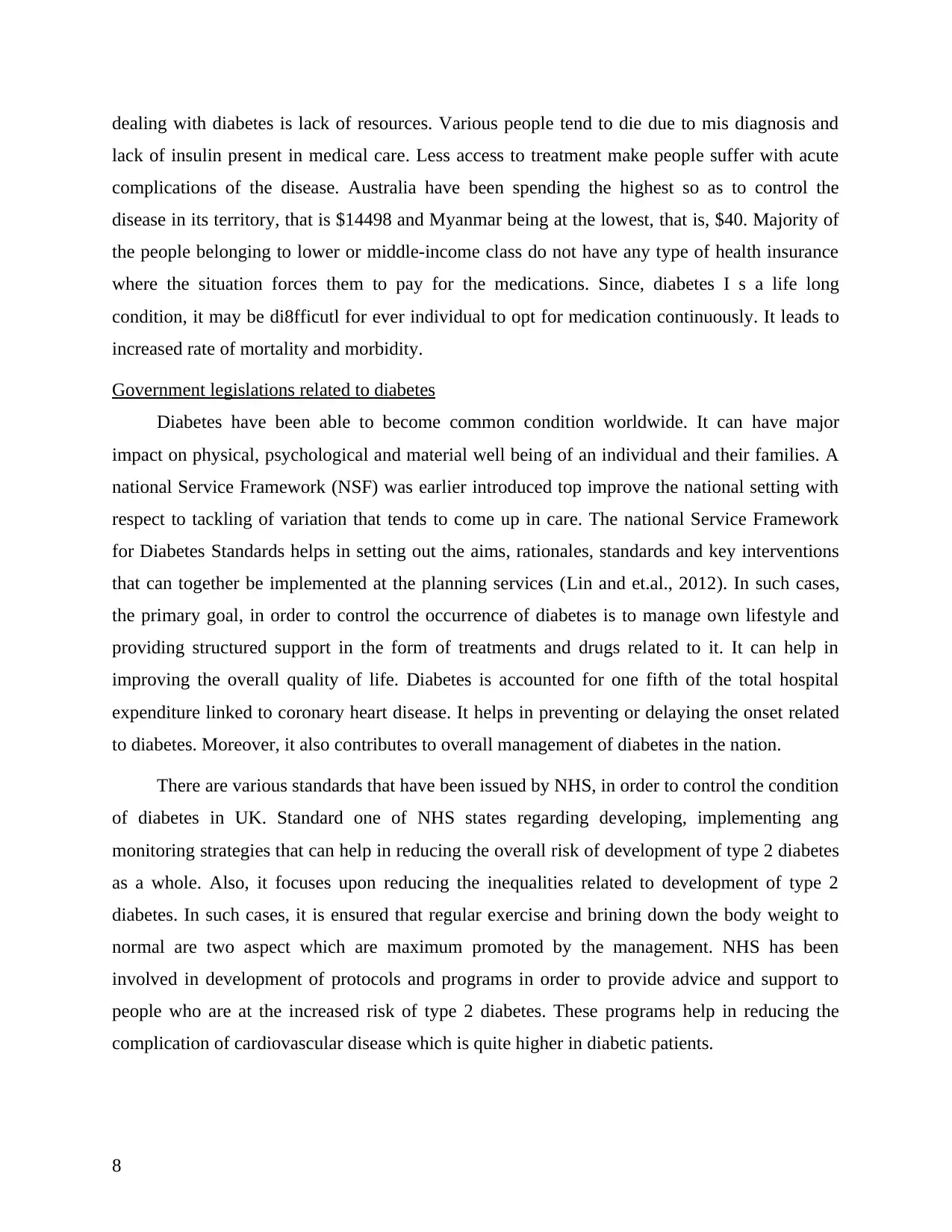
dealing with diabetes is lack of resources. Various people tend to die due to mis diagnosis and
lack of insulin present in medical care. Less access to treatment make people suffer with acute
complications of the disease. Australia have been spending the highest so as to control the
disease in its territory, that is $14498 and Myanmar being at the lowest, that is, $40. Majority of
the people belonging to lower or middle-income class do not have any type of health insurance
where the situation forces them to pay for the medications. Since, diabetes I s a life long
condition, it may be di8fficutl for ever individual to opt for medication continuously. It leads to
increased rate of mortality and morbidity.
Government legislations related to diabetes
Diabetes have been able to become common condition worldwide. It can have major
impact on physical, psychological and material well being of an individual and their families. A
national Service Framework (NSF) was earlier introduced top improve the national setting with
respect to tackling of variation that tends to come up in care. The national Service Framework
for Diabetes Standards helps in setting out the aims, rationales, standards and key interventions
that can together be implemented at the planning services (Lin and et.al., 2012). In such cases,
the primary goal, in order to control the occurrence of diabetes is to manage own lifestyle and
providing structured support in the form of treatments and drugs related to it. It can help in
improving the overall quality of life. Diabetes is accounted for one fifth of the total hospital
expenditure linked to coronary heart disease. It helps in preventing or delaying the onset related
to diabetes. Moreover, it also contributes to overall management of diabetes in the nation.
There are various standards that have been issued by NHS, in order to control the condition
of diabetes in UK. Standard one of NHS states regarding developing, implementing ang
monitoring strategies that can help in reducing the overall risk of development of type 2 diabetes
as a whole. Also, it focuses upon reducing the inequalities related to development of type 2
diabetes. In such cases, it is ensured that regular exercise and brining down the body weight to
normal are two aspect which are maximum promoted by the management. NHS has been
involved in development of protocols and programs in order to provide advice and support to
people who are at the increased risk of type 2 diabetes. These programs help in reducing the
complication of cardiovascular disease which is quite higher in diabetic patients.
8
lack of insulin present in medical care. Less access to treatment make people suffer with acute
complications of the disease. Australia have been spending the highest so as to control the
disease in its territory, that is $14498 and Myanmar being at the lowest, that is, $40. Majority of
the people belonging to lower or middle-income class do not have any type of health insurance
where the situation forces them to pay for the medications. Since, diabetes I s a life long
condition, it may be di8fficutl for ever individual to opt for medication continuously. It leads to
increased rate of mortality and morbidity.
Government legislations related to diabetes
Diabetes have been able to become common condition worldwide. It can have major
impact on physical, psychological and material well being of an individual and their families. A
national Service Framework (NSF) was earlier introduced top improve the national setting with
respect to tackling of variation that tends to come up in care. The national Service Framework
for Diabetes Standards helps in setting out the aims, rationales, standards and key interventions
that can together be implemented at the planning services (Lin and et.al., 2012). In such cases,
the primary goal, in order to control the occurrence of diabetes is to manage own lifestyle and
providing structured support in the form of treatments and drugs related to it. It can help in
improving the overall quality of life. Diabetes is accounted for one fifth of the total hospital
expenditure linked to coronary heart disease. It helps in preventing or delaying the onset related
to diabetes. Moreover, it also contributes to overall management of diabetes in the nation.
There are various standards that have been issued by NHS, in order to control the condition
of diabetes in UK. Standard one of NHS states regarding developing, implementing ang
monitoring strategies that can help in reducing the overall risk of development of type 2 diabetes
as a whole. Also, it focuses upon reducing the inequalities related to development of type 2
diabetes. In such cases, it is ensured that regular exercise and brining down the body weight to
normal are two aspect which are maximum promoted by the management. NHS has been
involved in development of protocols and programs in order to provide advice and support to
people who are at the increased risk of type 2 diabetes. These programs help in reducing the
complication of cardiovascular disease which is quite higher in diabetic patients.
8
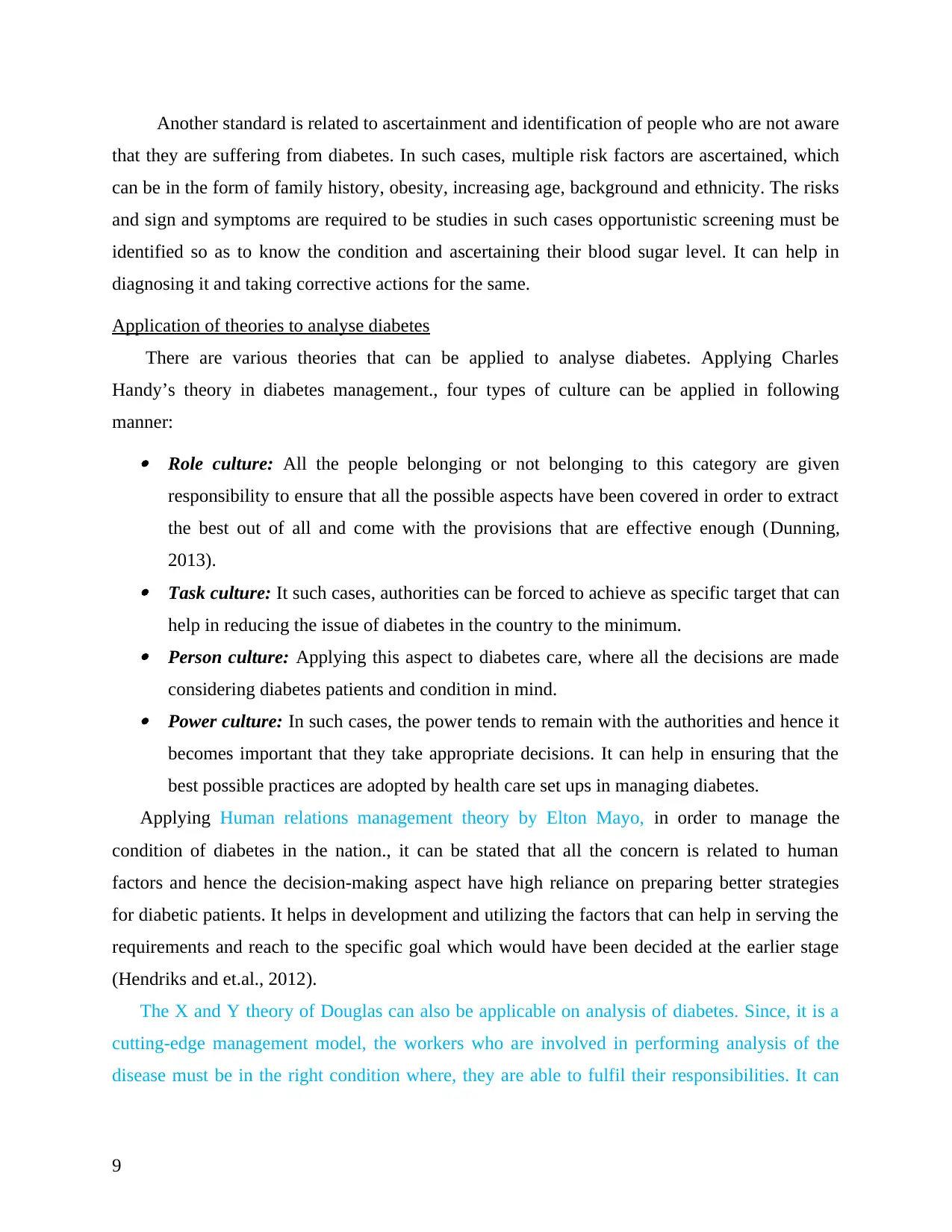
Another standard is related to ascertainment and identification of people who are not aware
that they are suffering from diabetes. In such cases, multiple risk factors are ascertained, which
can be in the form of family history, obesity, increasing age, background and ethnicity. The risks
and sign and symptoms are required to be studies in such cases opportunistic screening must be
identified so as to know the condition and ascertaining their blood sugar level. It can help in
diagnosing it and taking corrective actions for the same.
Application of theories to analyse diabetes
There are various theories that can be applied to analyse diabetes. Applying Charles
Handy’s theory in diabetes management., four types of culture can be applied in following
manner: Role culture: All the people belonging or not belonging to this category are given
responsibility to ensure that all the possible aspects have been covered in order to extract
the best out of all and come with the provisions that are effective enough (Dunning,
2013). Task culture: It such cases, authorities can be forced to achieve as specific target that can
help in reducing the issue of diabetes in the country to the minimum. Person culture: Applying this aspect to diabetes care, where all the decisions are made
considering diabetes patients and condition in mind. Power culture: In such cases, the power tends to remain with the authorities and hence it
becomes important that they take appropriate decisions. It can help in ensuring that the
best possible practices are adopted by health care set ups in managing diabetes.
Applying Human relations management theory by Elton Mayo, in order to manage the
condition of diabetes in the nation., it can be stated that all the concern is related to human
factors and hence the decision-making aspect have high reliance on preparing better strategies
for diabetic patients. It helps in development and utilizing the factors that can help in serving the
requirements and reach to the specific goal which would have been decided at the earlier stage
(Hendriks and et.al., 2012).
The X and Y theory of Douglas can also be applicable on analysis of diabetes. Since, it is a
cutting-edge management model, the workers who are involved in performing analysis of the
disease must be in the right condition where, they are able to fulfil their responsibilities. It can
9
that they are suffering from diabetes. In such cases, multiple risk factors are ascertained, which
can be in the form of family history, obesity, increasing age, background and ethnicity. The risks
and sign and symptoms are required to be studies in such cases opportunistic screening must be
identified so as to know the condition and ascertaining their blood sugar level. It can help in
diagnosing it and taking corrective actions for the same.
Application of theories to analyse diabetes
There are various theories that can be applied to analyse diabetes. Applying Charles
Handy’s theory in diabetes management., four types of culture can be applied in following
manner: Role culture: All the people belonging or not belonging to this category are given
responsibility to ensure that all the possible aspects have been covered in order to extract
the best out of all and come with the provisions that are effective enough (Dunning,
2013). Task culture: It such cases, authorities can be forced to achieve as specific target that can
help in reducing the issue of diabetes in the country to the minimum. Person culture: Applying this aspect to diabetes care, where all the decisions are made
considering diabetes patients and condition in mind. Power culture: In such cases, the power tends to remain with the authorities and hence it
becomes important that they take appropriate decisions. It can help in ensuring that the
best possible practices are adopted by health care set ups in managing diabetes.
Applying Human relations management theory by Elton Mayo, in order to manage the
condition of diabetes in the nation., it can be stated that all the concern is related to human
factors and hence the decision-making aspect have high reliance on preparing better strategies
for diabetic patients. It helps in development and utilizing the factors that can help in serving the
requirements and reach to the specific goal which would have been decided at the earlier stage
(Hendriks and et.al., 2012).
The X and Y theory of Douglas can also be applicable on analysis of diabetes. Since, it is a
cutting-edge management model, the workers who are involved in performing analysis of the
disease must be in the right condition where, they are able to fulfil their responsibilities. It can
9
⊘ This is a preview!⊘
Do you want full access?
Subscribe today to unlock all pages.

Trusted by 1+ million students worldwide

help them in initiating effective and appropriate decision for the team. Further, ambition of
incentives can help in increasing the overall productivity of the patients.
There are various types of styles. However, the best possible management style for
management of diabetes will be transformational style which can help in initiating change among
food habits of people. Moreover, bringing change in their lifestyle can also help in dealing with
the issue in the best possible manner.
Optimum utilization of the resources in such a manner that best possible practices can be
ensured to the people suffering from diabetes can help in reducing its impact on people. It also
helps in ensuring that all the available resources are optimally utilized so that prevalence of
diabetes can be reduced to the minimum.
CONCLUSION
From the above report, it can be concluded that, diabetes is a non-curable disease.
However, its prevalence can be reduced in people by ensuring that they follow healthy lifestyle
and indulge in certain physical activities. Further, there are altogether seven countries, having 10
million of people, who are suffering from diabetes. These countries are, Brazil, Russian
federation, Mexico, Indonesia, India, China and United States of America. Globally, 422 million
people suffer from it who belongs to the age between 20 to 79 years. It increases the importance
of development of strategic plans that can reduce or mitigate this growth that is happening in the
number of patients of diabetes.
RECOMMENDATIONS
Diabetes has emerged as a major issues which has direct as well as negative impact on the
health of people. Effective management is considered to be an important activity which assists in
minimising morbidity as well as premature mortality related to diabetes. Best practices are
considered to be as a valuable as well as beneficial source of practice-based evidence on
effective public health involvement enforced in real-life settings. The health care management is
taking high initiatives by organising the medical camp with the purpose of generating the
awareness about the way of reducing calories. Example of such event is Diabetes Prevention
Program organised by US National Institutes of Health. In these camps medical professional has
informed and suggested people to conduct physical activity or exercises. New medicines as well
as treatment were introduced for assisting the people in reducing the diabetes. Medication such
as metformin, a widely utilised as anti-diabetic medication for improving insulin sensitivity.
10
incentives can help in increasing the overall productivity of the patients.
There are various types of styles. However, the best possible management style for
management of diabetes will be transformational style which can help in initiating change among
food habits of people. Moreover, bringing change in their lifestyle can also help in dealing with
the issue in the best possible manner.
Optimum utilization of the resources in such a manner that best possible practices can be
ensured to the people suffering from diabetes can help in reducing its impact on people. It also
helps in ensuring that all the available resources are optimally utilized so that prevalence of
diabetes can be reduced to the minimum.
CONCLUSION
From the above report, it can be concluded that, diabetes is a non-curable disease.
However, its prevalence can be reduced in people by ensuring that they follow healthy lifestyle
and indulge in certain physical activities. Further, there are altogether seven countries, having 10
million of people, who are suffering from diabetes. These countries are, Brazil, Russian
federation, Mexico, Indonesia, India, China and United States of America. Globally, 422 million
people suffer from it who belongs to the age between 20 to 79 years. It increases the importance
of development of strategic plans that can reduce or mitigate this growth that is happening in the
number of patients of diabetes.
RECOMMENDATIONS
Diabetes has emerged as a major issues which has direct as well as negative impact on the
health of people. Effective management is considered to be an important activity which assists in
minimising morbidity as well as premature mortality related to diabetes. Best practices are
considered to be as a valuable as well as beneficial source of practice-based evidence on
effective public health involvement enforced in real-life settings. The health care management is
taking high initiatives by organising the medical camp with the purpose of generating the
awareness about the way of reducing calories. Example of such event is Diabetes Prevention
Program organised by US National Institutes of Health. In these camps medical professional has
informed and suggested people to conduct physical activity or exercises. New medicines as well
as treatment were introduced for assisting the people in reducing the diabetes. Medication such
as metformin, a widely utilised as anti-diabetic medication for improving insulin sensitivity.
10
Paraphrase This Document
Need a fresh take? Get an instant paraphrase of this document with our AI Paraphraser
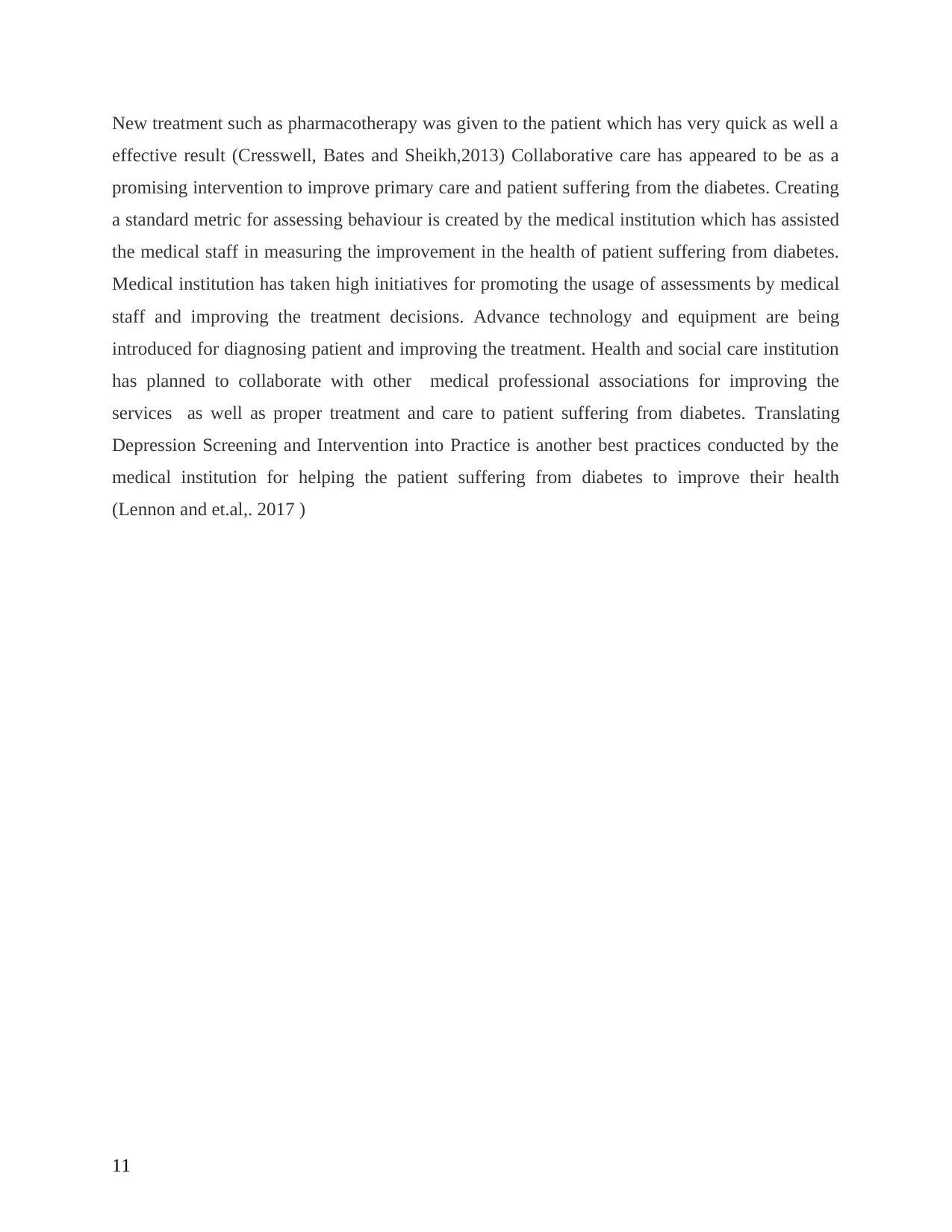
New treatment such as pharmacotherapy was given to the patient which has very quick as well a
effective result (Cresswell, Bates and Sheikh,2013) Collaborative care has appeared to be as a
promising intervention to improve primary care and patient suffering from the diabetes. Creating
a standard metric for assessing behaviour is created by the medical institution which has assisted
the medical staff in measuring the improvement in the health of patient suffering from diabetes.
Medical institution has taken high initiatives for promoting the usage of assessments by medical
staff and improving the treatment decisions. Advance technology and equipment are being
introduced for diagnosing patient and improving the treatment. Health and social care institution
has planned to collaborate with other medical professional associations for improving the
services as well as proper treatment and care to patient suffering from diabetes. Translating
Depression Screening and Intervention into Practice is another best practices conducted by the
medical institution for helping the patient suffering from diabetes to improve their health
(Lennon and et.al,. 2017 )
11
effective result (Cresswell, Bates and Sheikh,2013) Collaborative care has appeared to be as a
promising intervention to improve primary care and patient suffering from the diabetes. Creating
a standard metric for assessing behaviour is created by the medical institution which has assisted
the medical staff in measuring the improvement in the health of patient suffering from diabetes.
Medical institution has taken high initiatives for promoting the usage of assessments by medical
staff and improving the treatment decisions. Advance technology and equipment are being
introduced for diagnosing patient and improving the treatment. Health and social care institution
has planned to collaborate with other medical professional associations for improving the
services as well as proper treatment and care to patient suffering from diabetes. Translating
Depression Screening and Intervention into Practice is another best practices conducted by the
medical institution for helping the patient suffering from diabetes to improve their health
(Lennon and et.al,. 2017 )
11
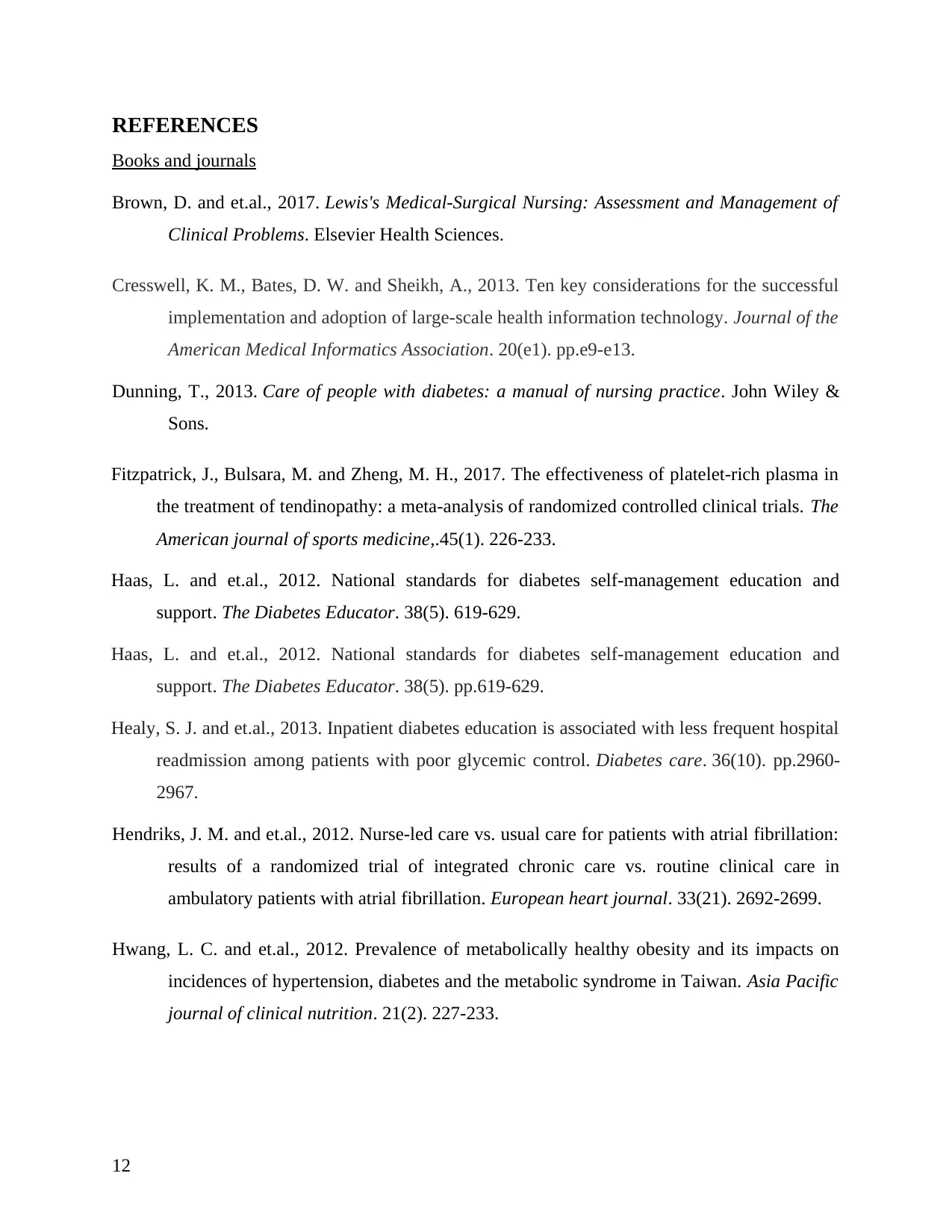
REFERENCES
Books and journals
Brown, D. and et.al., 2017. Lewis's Medical-Surgical Nursing: Assessment and Management of
Clinical Problems. Elsevier Health Sciences.
Cresswell, K. M., Bates, D. W. and Sheikh, A., 2013. Ten key considerations for the successful
implementation and adoption of large-scale health information technology. Journal of the
American Medical Informatics Association. 20(e1). pp.e9-e13.
Dunning, T., 2013. Care of people with diabetes: a manual of nursing practice. John Wiley &
Sons.
Fitzpatrick, J., Bulsara, M. and Zheng, M. H., 2017. The effectiveness of platelet-rich plasma in
the treatment of tendinopathy: a meta-analysis of randomized controlled clinical trials. The
American journal of sports medicine,.45(1). 226-233.
Haas, L. and et.al., 2012. National standards for diabetes self-management education and
support. The Diabetes Educator. 38(5). 619-629.
Haas, L. and et.al., 2012. National standards for diabetes self-management education and
support. The Diabetes Educator. 38(5). pp.619-629.
Healy, S. J. and et.al., 2013. Inpatient diabetes education is associated with less frequent hospital
readmission among patients with poor glycemic control. Diabetes care. 36(10). pp.2960-
2967.
Hendriks, J. M. and et.al., 2012. Nurse-led care vs. usual care for patients with atrial fibrillation:
results of a randomized trial of integrated chronic care vs. routine clinical care in
ambulatory patients with atrial fibrillation. European heart journal. 33(21). 2692-2699.
Hwang, L. C. and et.al., 2012. Prevalence of metabolically healthy obesity and its impacts on
incidences of hypertension, diabetes and the metabolic syndrome in Taiwan. Asia Pacific
journal of clinical nutrition. 21(2). 227-233.
12
Books and journals
Brown, D. and et.al., 2017. Lewis's Medical-Surgical Nursing: Assessment and Management of
Clinical Problems. Elsevier Health Sciences.
Cresswell, K. M., Bates, D. W. and Sheikh, A., 2013. Ten key considerations for the successful
implementation and adoption of large-scale health information technology. Journal of the
American Medical Informatics Association. 20(e1). pp.e9-e13.
Dunning, T., 2013. Care of people with diabetes: a manual of nursing practice. John Wiley &
Sons.
Fitzpatrick, J., Bulsara, M. and Zheng, M. H., 2017. The effectiveness of platelet-rich plasma in
the treatment of tendinopathy: a meta-analysis of randomized controlled clinical trials. The
American journal of sports medicine,.45(1). 226-233.
Haas, L. and et.al., 2012. National standards for diabetes self-management education and
support. The Diabetes Educator. 38(5). 619-629.
Haas, L. and et.al., 2012. National standards for diabetes self-management education and
support. The Diabetes Educator. 38(5). pp.619-629.
Healy, S. J. and et.al., 2013. Inpatient diabetes education is associated with less frequent hospital
readmission among patients with poor glycemic control. Diabetes care. 36(10). pp.2960-
2967.
Hendriks, J. M. and et.al., 2012. Nurse-led care vs. usual care for patients with atrial fibrillation:
results of a randomized trial of integrated chronic care vs. routine clinical care in
ambulatory patients with atrial fibrillation. European heart journal. 33(21). 2692-2699.
Hwang, L. C. and et.al., 2012. Prevalence of metabolically healthy obesity and its impacts on
incidences of hypertension, diabetes and the metabolic syndrome in Taiwan. Asia Pacific
journal of clinical nutrition. 21(2). 227-233.
12
⊘ This is a preview!⊘
Do you want full access?
Subscribe today to unlock all pages.

Trusted by 1+ million students worldwide
1 out of 13
Related Documents
Your All-in-One AI-Powered Toolkit for Academic Success.
+13062052269
info@desklib.com
Available 24*7 on WhatsApp / Email
![[object Object]](/_next/static/media/star-bottom.7253800d.svg)
Unlock your academic potential
Copyright © 2020–2025 A2Z Services. All Rights Reserved. Developed and managed by ZUCOL.





